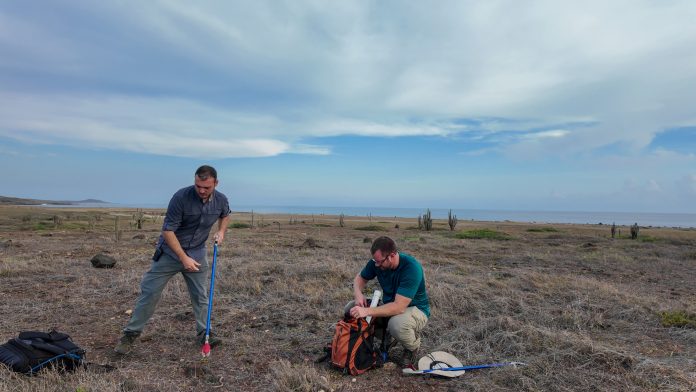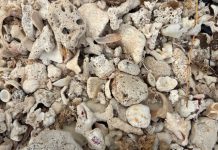(Oranjestad)—In October, Aruba Conservation Foundation (ACF) received a team of experts from The Toledo Zoo & Aquarium for a survey of the Rattlesnake population on our island. This visit was unique, as for the first time, a new method was introduced to observe the Rattlesnake in the wild — the use of a thermal drone, which provides a better indication and understanding of where the Rattlesnake lives and how it moves around during the day.
The Toledo Zoo is a zoological park and conservation foundation based in Ohio, USA, with more than 125 years of operation. The park houses over 10,000 individual animals from 720 species and participates in nearly 80 species survival programs. The collaboration between the Toledo Zoo and Arikok Park began back in the 1980s, as the experts explained. This year, ACF and the Toledo Zoo are strengthening their partnership and continuing the work already in progress.
Nick Gordon, Manager of Herpetology at The Toledo Zoo, was among several experts—including Dr. Jeff Goessling, who has 15 years of experience conducting research on Aruba’s reptiles—who visited for the rattlesnake survey. Gordon oversees a massive and diverse collection of venomous reptiles, amphibians, and invertebrates, including certain insects and desert or dry-climate species like scorpions, at The Toledo Zoo. He is also the coordinator of the species survival plan for Aruba’s Rattlesnake. As he explained, during the 2000s, Rattlesnakes were found outside the limits of the park in areas not considered part of their natural habitat. Since those locations were not suitable habitats, to prevent their death, the snakes were taken to Toledo, where experts could keep them in captivity and breed them for genetic diversity.
He explained that there are several reasons for this. The main reason is to maintain a Rattlesnake population that can function as a “safety net” in case the wild population in Aruba were to go extinct. In such an extreme case, they could technically reintroduce the species to Aruba, although he emphasized that this also comes with challenges. This conservation method is not unique to ACF, as the organization is also working with other partners in the Netherlands to assist in breeding the Lora (Aruban parrot), part of a reintroduction program for the species that was once extinct on the island. However, for the Rattlesnake, the main goal is to preserve the existing population in Aruba. And this has its benefits, as Dr. Matt Cross, conservation biologist at The Toledo Zoo, emphasized: “Conservation actions influence everything,” he said, “because what’s good for the Rattlesnake tends to be good for all organisms living on the island.”
Another aspect of the project is to provide education about the Rattlesnake, both for Aruba’s visitors and for biologists. According to Park Ranger Roger Solognier—who is a terrestrial biodiversity conservation ranger with ACF—there is still a lot that science doesn’t know, especially about the Rattlesnake. Collecting and tagging them helps experts study the species continuously, as the data gathered each year may change. With this project, ACF and The Toledo Zoo are studying the Rattlesnake’s ecology. According to them, the animals are crepuscular, meaning they are most observable early in the morning or late in the afternoon when the sun is lower. Another part of their research focuses on the endemic snake’s feeding habits, daytime movements, hiding spots during dry and hot seasons, the challenges they face in the wild, and their breeding patterns.
To support this, the experts from The Toledo Zoo will begin taking blood samples from Rattlesnakes to check for traces of inbreeding, considering the small population concentrated in one part of the island. Gordon explained that what they learn about Rattlesnakes in captivity can help apply conservation techniques in the wild. As he mentioned, the goal is to keep the population stable.
This particular visit was unique because it introduced a new method in Aruba for surveying Rattlesnakes: the use of a special drone that helps detect the snakes and their movements. Dr. Paul Keenlance from the Department of Biology at Grand Valley State University explained that he has been working for several years on different ways to use drones to study wildlife. The drone used in the recent Rattlesnake survey was equipped with two cameras—a normal one and a thermal one. The thermal camera was more effective during the day because, when it gets hot, the Rattlesnakes remain hidden until the sun goes down. The thermal camera detects them through sensors that can distinguish temperature levels. As Keenlance explained, many times the Rattlesnake is cooler than the ground, making it appear as a lighter color on the camera. Keenlance predicted that this type of technology will become increasingly common in conservation work.
Although new technologies can provide a deeper view of our ecosystems, the experts emphasized that the human aspect remains important. As Cross said, “Conservation is a human issue. We need to influence our own behavior, and we’ve seen that humans have a major impact on conservation, for better or worse.”
That’s why awareness remains a major mission in the world of conservation—because people need to understand what kinds of actions they should take, as Solognier emphasized. And these can be simple actions, such as watching your step or avoiding damage to habitats. It’s also important to change the narrative about human intervention. It’s known that humans can pose the biggest threat to nature, but they can also be its greatest guardians and defenders. We should be proud and celebrate the fact that we have a unique species like the Rattlesnake on our island, instead of seeking ways to capture or take their rattles. Appreciate the rare experience of seeing a Rattlesnake, as they are very uncommon, especially in populated areas. The experts encourage people to cherish these moments and take care not to disturb the animal or its habitat.
People can also help protect the Rattlesnake and other wildlife on our island by using ACF’s Wildlife Hotline. The organization urges people to contact them via the hotline when spotting a rattlesnake, especially in areas where they are not typically seen. All such data can be useful for further research.
You can contact ACF through the hotline at 592-4476. The organization explained that they do not take calls via WhatsApp because the ranger in contact may be occupied with park duties or may not have connection inside the park. In emergency cases, it is advised to call the ACF department directly.
Photos courtesy of ACF.
















